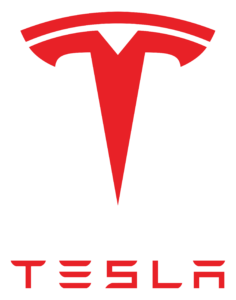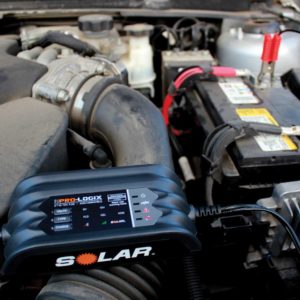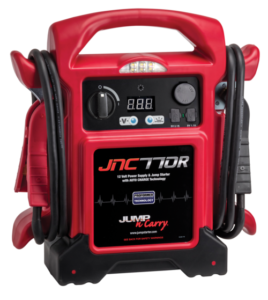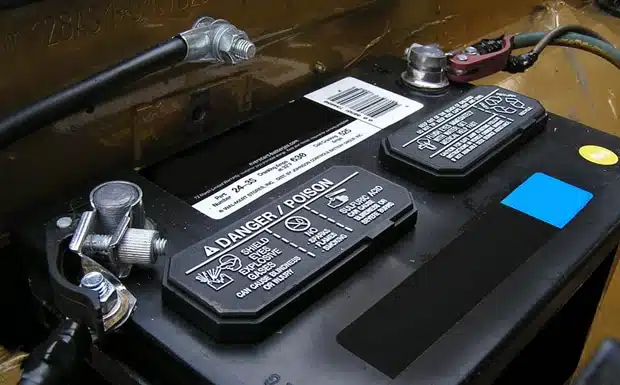For many EV owners, it can come as a big surprise when they find out that their Battery Electric Vehicle (BEV) contains a 12 Volt battery as a critical component in its electrical system. In fact, virtually every EV model in North America is configured with a 12 Volt battery among its components. Although this may seem anachronistic, once you break it down, it makes a lot of sense. In this month’s article, we are going to dive into the use of 12 Volt batteries within EV architectures and the service implications for them. Then, we’ll wrap things up with another surprising 12 Volt battery deployment that’s worth noting.
Yes, It Does Have a 12 Volt Battery
We’ll start with this great introductory article from CarandDriver.com. It does a nice job of addressing the fact that your EV contains a 12 Volt battery, why this is so and digs into what can happen if the 12 Volt battery dies or is excessively discharged. In the article, they quote a Hyundai engineer, who stated, “All the ECUs in the vehicle are powered from the low voltage, as well as the power relays that separate power from the high-voltage battery pack and the rest of the high-voltage network in the car,” he said. “That separation allows us to safely disconnect the high voltage from the low voltage when the vehicle is not being driven or in the event of a crash.”
This sums it up pretty well. Many subsystems within the EV electrical system utilize low voltage power to run them. In many cases, the system will have a stand-alone 12V battery and in others, the 12V battery system with be embedded within the larger high voltage battery. When it is a stand alone battery, it can be either a lithium (usually LiFePO4) or lead acid (usually an AGM) battery. So, the service implications often depend on the specific configuration and battery type involved. More on the service implications below, but this article is a great place to start when it comes to learning about the use of 12V batteries and systems within EV designs.
Tesla is Not Immune
 The presence of a 12 Volt battery is true for Tesla as well. I know, hard to believe, but it’s true. Recent Model S and X productions have switched to lithium 12V batteries, while older Model S and X, as well as all vintages of Model 3 and Y, utilize AGM lead acid 12V batteries. In fact, this was an evolution from the early Roadsters, which did not incorporate a 12V into their architecture. This article, from evgoforth.com, does a really good job of reviewing Tesla use of 12V batteries in their vehicle design.
The presence of a 12 Volt battery is true for Tesla as well. I know, hard to believe, but it’s true. Recent Model S and X productions have switched to lithium 12V batteries, while older Model S and X, as well as all vintages of Model 3 and Y, utilize AGM lead acid 12V batteries. In fact, this was an evolution from the early Roadsters, which did not incorporate a 12V into their architecture. This article, from evgoforth.com, does a really good job of reviewing Tesla use of 12V batteries in their vehicle design.
The article also deals with the practicalities of 12V battery degradation, the consequences of a dead 12V battery in a Tesla, replacement options and the repair procedure for installing a new battery. As usual, there are a lot of choices to be made, such as whether to go to Tesla for service, opt for an aftermarket provider or try to manage it yourself. Then, of course, there’s the question of what to choose for your replacement, for instance, stick with an AGM battery or upgrade to LiFePO4? Again, the article walks through this decision tree logically and clearly. It is a worthwhile read.
Jump Starting an EV?
If you have checked out the above articles, you will know that there can be situations where an EV requires a jump start of sorts. EVs can be assisted to start when the 12V battery has become too depleted to allow the high voltage battery to power up. In an EV jump start, you are essentially augmenting the 12V battery, like you would with a traditional jump start, but there is no high current surge like there would be during the jump starting application on an internal combustion engine vehicle.
This useful video by kmanAuto on YouTube walks through the process of jump starting a Tesla Model S using a traditional jump starter. The narrator begins by showing how to access the electrical system via starting points right behind the front bumper shroud. He then walks through the connection process and explains how the jump starter provides auxiliary capacity to the system to allow it to power up. So, yes, jump starting an EV is sometimes necessary.
Mustang Mach-E Jump Starting Need?
You might have thought that the switch to an EV would mean you could leave your old jump starter behind. As we have seen in the above Tesla example, though, the need for a jump starter is relatively common for older EVs, as their 12V battery degrades over time and reaches its end of life. But, might you need a jump starter for a new EV just as often as you would if you were driving a traditional ICE vehicle? If your EV of choice is the Mustang Mach-E, the answer might be yes.
As this article from cnet.com recounts, a glitch in the Mach-E software caused many vehicles to drain the 12 Volt battery, resulting in many owners finding their vehicle rendered unable to power up. The problem was compounded by the fact that the battery couldn’t be accessed because the trunk, in which it was located, was electronically latched. Yikes! Obviously, these are sophisticated vehicles and we aren’t trying pick on Ford here. The key point is that the 12V battery still plays a crucial role in these systems.
My ICE Vehicle has What Battery?
We’ll end with a slightly different, but related trend in 12 Volt battery design and deployment, and that is the use of lithium-ion starting batteries with internal combustion engine (ICE) vehicle systems. As we noted above, Tesla has moved to lithium 12V batteries on Models S and X, which sort of makes sense. But, did you know that BWM M-Series vehicles utilize lithium 12V starting batteries? As this article by Brian Sexton on import-car.com explains, BMW has been using these batteries since the 2014 model year.
For technicians and vehicle owners alike, it is important to know the type of battery deployed in a vehicle and ensure that the equipment that you use to service that battery is designed for that purpose. This article provides a great overview of BMW’s use of these batteries and the service implications for them. Just like AGM batteries, lithium starting batteries (most of which are LiFePO4 lithium chemistry batteries) require precise charging control and specific charging parameters to properly service them. You cannot use a battery charger designed for use with lead acid batteries on a lithium battery. You are likely to overcharge the battery, causing damage to a very expensive vehicle component.
When it Comes to Servicing 12V EV Batteries, We've Got You Covered
Eventually, the 12V battery in an EV will require maintenance and service. This could mean periodic charging to extend the battery’s lifespan, periodic testing to better understand where the battery is in its life cycle or the occasional jump start due to an excessively discharged battery. In all of these cases, we can help.
 Charging – Our PRO-LOGIX line of battery chargers offers a wide range of service support for vehicles of all shapes and sizes. In particular, our PL2140 – 6/12V 4A Battery Charger/Maintainer is a versatile tool that can provide service to Flooded, AGM, Spiral Wound, Deep Cycle, Marine and LiFePO4 lithium batteries. So, whether you need to charge a Tesla Model S lithium 12V battery, a Tesla Model 3 AGM 12V battery, a BMW M4 12V starting battery, a tractor battery or a wave runner battery, the PL2140 can do it safely and effectively, restoring reserve capacity and extending its life.
Charging – Our PRO-LOGIX line of battery chargers offers a wide range of service support for vehicles of all shapes and sizes. In particular, our PL2140 – 6/12V 4A Battery Charger/Maintainer is a versatile tool that can provide service to Flooded, AGM, Spiral Wound, Deep Cycle, Marine and LiFePO4 lithium batteries. So, whether you need to charge a Tesla Model S lithium 12V battery, a Tesla Model 3 AGM 12V battery, a BMW M4 12V starting battery, a tractor battery or a wave runner battery, the PL2140 can do it safely and effectively, restoring reserve capacity and extending its life.
 Testing – Our SOLAR BA Series battery testers can test six different lead acid starting battery types, including Flooded, AGM, Spiral Wound, Gel Cell, AGM Start-Stop and Enhanced Flooded (EFB) batteries. Diagnosis is quick and easy, with the tester walking the operator though the testing process and providing both a numerical and pass/fail result. And, with several models to choose from, there’s a BA Series tester for every user type from the weekend warrior to a busy automotive service garage.
Testing – Our SOLAR BA Series battery testers can test six different lead acid starting battery types, including Flooded, AGM, Spiral Wound, Gel Cell, AGM Start-Stop and Enhanced Flooded (EFB) batteries. Diagnosis is quick and easy, with the tester walking the operator though the testing process and providing both a numerical and pass/fail result. And, with several models to choose from, there’s a BA Series tester for every user type from the weekend warrior to a busy automotive service garage.
 Jump Starting – While the jump starting demands of EVs are less rigorous than those of the typical ICE vehicle, quality and reliability still count in the EV game. You want your jump starter to answer the call when you need it the most. It needs to have sufficient capacity to be of use to you in getting your EV back in service and it needs to consistently hold a charge so that when you reach for it, it is ready for action. Jump-N-Carry and Booster PAC have built their reputation on delivering dependable service, jump after jump, for hundreds of thousands of service facilities around the world. You can depend on models like the JNC770 to power you through to service success, whether you are servicing an EV or ICE vehicle.
Jump Starting – While the jump starting demands of EVs are less rigorous than those of the typical ICE vehicle, quality and reliability still count in the EV game. You want your jump starter to answer the call when you need it the most. It needs to have sufficient capacity to be of use to you in getting your EV back in service and it needs to consistently hold a charge so that when you reach for it, it is ready for action. Jump-N-Carry and Booster PAC have built their reputation on delivering dependable service, jump after jump, for hundreds of thousands of service facilities around the world. You can depend on models like the JNC770 to power you through to service success, whether you are servicing an EV or ICE vehicle.











4 Responses
Outstanding article as is the case with every product I’ve purchased from your company over the years
Don – Thanks for your comment. We are glad that you found the article helpful. Jim from Clore Automotive
Can you boost a lifep04 12volt battery with a clore booster pac? Also can you use one of the small lithium booster pacs on a lifep04 battery.
Northern Import – Thanks for your question. Yes, you can use a lead acid jump starter (like our Booster PAC or JNC units) or a lithium jump starter (like our JNC units) to jump starter a ICE vehicle with a 12V LiFePO4 lithium starting battery, for example, an M Series BMW. Thanks again, Jim from Clore Automotive